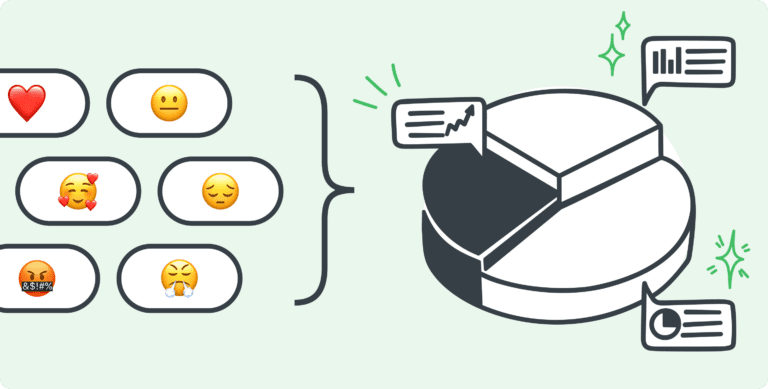The voice of the customer (VoC) plays an integral role in the world of business. It provides valuable insights into how customers perceive products, services, and the overall customer experience. According to estimates from Bain & Company, companies that excel at VoC typically see a 4-8% revenue growth above market.
Such numbers outline the importance of understanding what your customers are saying. It can significantly improve satisfaction and business growth.
In this article, we’ll cover everything you need to know about the voice of the customer.
Understanding The Voice Of The Customer
The voice of the customer (VoC) refers to information or insights that customers provide about their needs, preferences, and perceptions regarding a product or service. VoC can also be interpreted as customer feedback.
VoC data is typically collected through surveys, interviews, focus groups, or customer complaints and feedback. Companies use this information to improve their products and services.
However, several biases could occur when collecting customer feedback. They include:
- Halo effect bias – when a customer’s overall impression of a company influences their perception of specific aspects of the company, such as its products or services.
- Social desirability bias – the customers are more likely to provide positive feedback to avoid being perceived as complainers or too nitpicky.
- Sunk cost bias – customers are more likely to provide positive feedback if they have invested more time or money in a product or service.
- Negativity bias – customers are more likely to remember and provide feedback on negative experiences rather than positive experiences.
- Confirmation bias – an error of interpretation committed by decision-makers within a company. It happens when the customer’s feedback is interpreted to confirm pre-existing beliefs or hypotheses.
While collecting customer feedback aims to drive genuine improvements in products or the delivery of services, businesses often misinterpret the entire concept.
Common misconceptions include:
- ⛔ Customer feedback is the same thing as customer complaints.
- ⛔ Customer feedback is only given as a suggestion.
- ⛔ It’s not important to thank customers for their feedback.
- ⛔ Designing surveys for feedback doesn’t really matter when obtaining customer feedback.
- ⛔ Customer feedback is only valid in large numbers, and it doesn’t concern small businesses.
How to Interpret Feedback Correctly (and Avoid Misinterpretation)
📊 Focus on behavior and not the individual
Because businesses are run by humans and not machines, it’s unsurprising that we will take offense to customer feedback every once in a while. However, this potentially compromises the company’s position and limits its ability to improve satisfaction.
This is why you should focus on your actions as a business rather than the personal opinions launched at you.
That allows you to identify patterns and trends in customer feedback, rather than getting stuck on a single instance of (potentially biased) feedback. It can help you recognize areas for improvement in your products or services and identify common issues that many customers are experiencing.
💡 Focus on the things that can be changed
This is closely tied to the first point, as some things are beyond our span of control. When businesses focus on issues that can’t be changed, it can lead to frustration and a feeling of helplessness.
But by focusing on the things that can be changed, businesses can identify specific areas where they can make improvements and take steps to address customer dissatisfaction.
👀 Look for patterns
By identifying common themes or issues that come up in multiple responses, you can start to build a picture of what customers are really looking for in your product or service. This can help you make more informed decisions about ways to improve your offering and meet your customers’ needs.
Looking for patterns also helps you identify outliers or exceptions to the overall feedback. These can be useful in understanding the specific needs of individual customers. If you see a specific complaint that only one customer has made, you might not take it as seriously as something that multiple customers have complained about.
🔍 Use tools that will help you monitor and track customer feedback
Tracking and monitoring customer feedback is important because it allows your business a chance to accomplish a few things. For one, it could help in identifying customer trends. It could also help you improve customer experience, improve marketing strategies, develop competitive advantages, and measure brand loyalty.
So how do you track customer feedback?
Surveys can be used to gather feedback on a wide range of issues, including product quality and customer satisfaction. Customer feedback management tools like Simplesat let you collect, measure, and publish customer feedback through a variety of surveys, making VoC a part of your every decision.
The best data comes directly from the customers. If you ask the right questions in the right way, they’ll be happy to give you feedback. And you can avoid common biases by distributing surveys often and across different channels.
In addition to asking for survey feedback, you could also use online reviews on platforms such as Yelp, TripAdvisor, and Google. Such platforms allow users to leave reviews that can be filtered and used to gather feedback.
Social media listening is another way to gauge VoC, but it can be misleading when used on its own. Remember, not all of your customers use Twitter or Facebook to share their thoughts! And there’s a tendency to only post very strong opinions to social media, which makes biases likely.
Surprisingly, you can also use VPNs as a tool to better understand your customers. Reliable VPNs let you work around firewalls and geo IP filtering, so you can stay in touch with an international customer base without any blind spots.
In Conclusion
As a business, you have a ton of operational and strategic goals to focus on simultaneously. Understandably, customer feedback can’t be your main priority. Nonetheless, communicating with customers and understanding their experiences is vitally important. It allows your business a chance to increase loyalty, identify mistakes before they spiral out, and – most importantly – it makes it easier to stay ahead of the competition.
So choose your tools wisely, look out for any biases that may seep in, and maintain a sense of humility. Customer feedback is a powerful resource, but only if you’re willing to learn from it.













